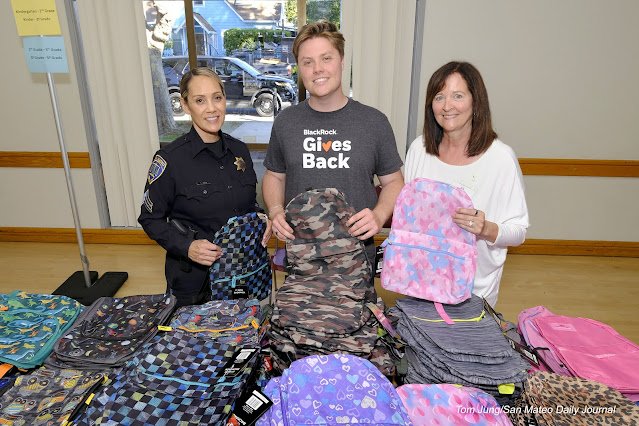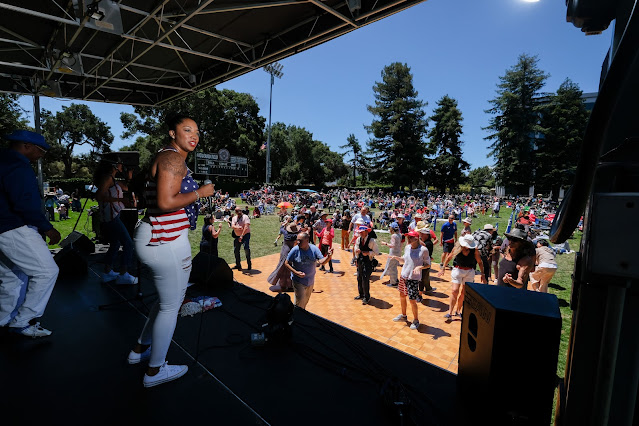
"Preparation is everything until the battle starts, and then it doesn't mean anything." So said Dwight Eisenhower, and probably many other strategists with slight variations. This assignment represented a challenge to my ability to deliver a meaningful image of this Cirque du Soleil performer, who performed a variety of moves on a ladder high above the stage. Honestly, I was busy thinking about ways to capture an image of a performer standing on a ladder ten feet above the stage.
This photo was part of the online Press Packet that is often sent to bloggers who are writing about the event. Wonderful as they were, they weren't suitable for an article highlighting a single performer. My subject, Clement Malin, is the one standing on the ladder.
When my editor asked to make a photo, she wanted one that emphasized the performer in his environment. After seeing this photo, I wondered how I could get my camera high enough to suggest the height where he worked. I believed that if I could bring his shoulders to a height of ten feet off the stage I had enough bits and pieces to make the shot. My kit would include:
- Two twelve-foot Manfrotto Light Stands. I could have one for the key light, and one to use as a free-standing monopod, unless I needed a "kicker" highlight for my subject or the background.
- One heavy duty monopod with a ball head to support the camera.
My 10-24 F 4.0 lens would be mounted on my Fuji T-4 camera body. Because of the T-4's fully articulated LCD display, I could mount the camera on the monopod and rotate the display so that it could be seen from below. I planned to use both hands to hold the monopod, so I wouldn't have a free hand to control the camera through my smartphone.
Exposure Control: Camera settings would be adjusted manually, but making the exposure would be a problem. There were two possible approaches:
- Self Timer: While this would be the simplest choice, there is a major problem. When the timer is activated, focus would be locked, which has no relationship to the actual shooting distance once my camera was hoisted to the subject's eye level. I could have manually set the focus, but trying to consistently position the camera while swaying at the end of a monopod held high overhead. The worst part is the self timer must be set for each shot.
- Interval Timer: The camera body could be programmed to make a series of exposures at specified intervals. There are two key settings: Interval and the Number Of Times. The major advantage is the focus is determined at the moment of exposure. I had planned to set the camera to five exposures at ten-second intervals. I would activate the Interval Timer (wasting the first shot), hoist the camera to Mr. Malin's eye level, and tell him to change his expression after each pop of the flash. I could easily watch the action with the LCD panel rotated so I could watch from below.
Day Of The Shoot: Despite my native San Franciscan status, I dislike taking assignments in my hometown. The difficulty finding parking and schlepping my gear over long distances is often daunting. I ended up paying $50.00 to park in the "reserved" lot which brought me a short distance from the main entrance. Once parked, I called Kevin, my handler for the day, and was told to meet him at the back gate at the other side of the venue. After the two block walk, Keven ushered me into the "big top", the huge tent the Cirque installs at every performance.
Now The Bad News: I was told that I would be photographing Mr. Malin in the "workout room". The ladder could not be used on the padded exercise area, and that the props would be a series of cardboard boxes that can be seen in the background of the Cirque publicity shot. The Good News was that my equipment and I would be standing firmly on the floor of the tent.
For the shot I decided to use a reflective umbrella half-opened to concentrate the light. This would give me light softer than a bare bulb flash and more contained. Positioning the flash inside the umbrella prevents the light from spilling onto the foreground, It is also easy to aim directly at your subject. For my accent light I mounted a grid spot on a second flash and positioned it opposite my key light. This would give the shot a theatrical look. As luck would have it, Kevin came by to see how things were going, and asked if he could be of any assistance. I thanked him, and asked him to stand where I planned to position Mr. Malin when he arrived on set. After one hasty test shot, I was satisfied that my lighting solution would work.
Since I was now shooting from a lower angle, I stayed with my Fuji T-2 body because the LCD panel flips down in alignment with the lens axis, which I find easier to use. Shot from a low camera position, you can see the shadow cast by the kicker light I placed in the background just behind my subject. It was triggered by the same controller I used for the key light.
You can see that by shooting from a low angle I could use the ceiling "hot spot" created by a utility light as a visual element in the background. When I showed the image to Kevin, he was pleasantly surprised, and noticed the exposed work area in the background, which he had the technicians draw the curtain to conceal it.
When Mr. Malin arrived on set, I showed him this photo, and he was intrigued by the shot. We did have to work within the confines of a horizontal shot, a potential obstacle because Mr. Malin's work is mostly vertical in nature. He brought some of the cardboard boxes he stacks during his performance, so these were my only props. I also had him kneel so I could keep him within the confines of a horizontal format.
Towards the end Mr. Malin and I were having fun improvising visual stunts on the spot, perhaps waiting for some inspirational pose to bring all the visual elements together.
Color Contamination: I didn't count on the athletic mats reflecting as much purple light as they did, as you can see the tint in the box bottoms. Also, the smooth white cardboard made the boxes extremely bright, but I didn't get to choose the props, so I did the best with what I had.
You will notice the Accent Light behind Mr. Malin's right hip. The Fuji lens handled potential flaring very well, as in-frame point light sources can produce some unwanted flare in the image. I also got a nice sun star radiating from the flash, something I wouldn't have had if his body completely blocked the light. He just moved out of position at the moment of exposure. It isn't noticeable since there is another, even larger highlight on the ceiling.
The assignment was a lot of fun in spite of the difficulties encountered. My"airborne camera" approach was an interesting solution, and one I hope to apply in the near future.


















































